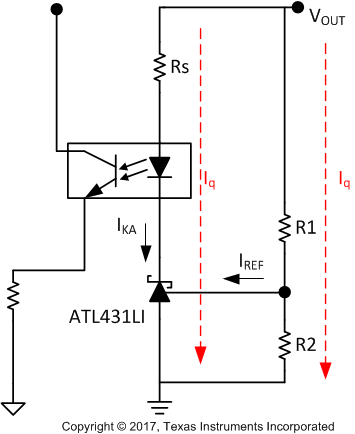SLVSDU6D July 2017 – November 2019 ATL431LI , ATL432LI
PRODUCTION DATA.
- 1 Features
- 2 Applications
- 3 Description
- 4 Revision History
- 5 Device Comparison Table
- 6 Pin Configuration and Functions
- 7 Specifications
- 8 Typical Characteristics
- 9 Parameter Measurement Information
- 10Detailed Description
- 11Applications and Implementation
- 12Power Supply Recommendations
- 13Layout
- 14Device and Documentation Support
- 15Mechanical, Packaging, and Orderable Information
Package Options
Mechanical Data (Package|Pins)
- DBZ|3
Thermal pad, mechanical data (Package|Pins)
Orderable Information
11.2.4.1.1 Detailed Design Procedure
In this example a simplified design procedure will be discussed. The compensation network for the feedback network is beyond the scope of this section. Details on compensation network can be found on SLUA671.
The goal of this design is to design a low standby current feedback network to meet the Europe CoC Tier 2 and United States DoE Level VI requirements. To meet the design requirements, the system standby power needs to be below 75mW. In order to meet this, the feedback network needs to consume less than 40mW to allow margin for the power losses on the primary side controller and passive components and this can pose a challenge in systems greater than 10V.
 Figure 29. Feedback Quiescent Current
Figure 29. Feedback Quiescent Current